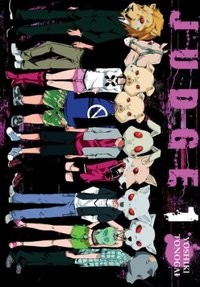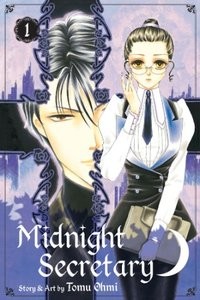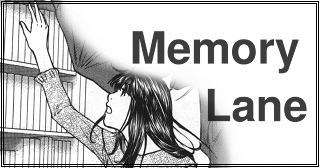RIGHT TURN ONLY!!
'Round Midnight
by Carlo Santos,

How lovely of San Diego to wait until September to dump its muggy, greasy August weather upon us. As I wait for this heatwave to break, I'm going to gaze wistfully into the distance and mutter, "Autumn is coming..."
ATTACK ON TITAN

Vol. 6
(by Hajime Isayama, Kodansha Comics, $10.99)
FROM THE BACK COVER:
"On the way to Eren's home, deep in Titan territory, the Survey Corps ranks are broken by a charge led by a female Titan! But this Abnormal is different—she kills not to eat but to protect herself, and she seems to be looking for someone. Armin comes to a shocking conclusion: She's a human in a Titan's body, just like Eren!"
EVIDENCE FOR:
Why do anime directors love Attack on Titan? Because Hajime Isayama is so good with action scenes, the storyboards are practically laid out in manga form already. Armin's escape from the Female Titan is like being right there on horseback with him: the landscape rushes past in a blur, dizzying angles force you to keep your eyes open, and the sight of allies locked in battle is a heart-pounding experience. The shocking intelligence and speed of the Female Titan is also on display in these chapters, in images both awe-inspiring and terrifying. But the thrills don't stop there: a change of course brings the Survey Corps into a deep forest, where new scenery, new challenges, and new strategies (how do we use all these trees to our advantage?) await. There's also plenty of drama to go with the action as Eren has to make a pivotal decision about whether to go it alone with his abilities, or to trust in those around him. The tension leading up to his decision—accompanied by an illuminating flashback, and later followed by an incredible burst of action—makes for a fantastic last chapter of this volume.
EVIDENCE AGAINST:
This volume of Attack on Titan does such a good job of speeding from one set-piece to the next that it's easy to overlook the shallow story content. Armin, Jean, and Reiner's escape from the Female Titan is a great opener—but they doesn't accomplish much else, aside from bringing out Armin's hypothesis and having a serious tactical discussion. It's the same problem in the middle chapters: people are either riding away in a panic, or they're just talking tactics, whether it's how to protect Eren or "Why are we standing among these trees?" The only time the story expands to look at the big picture is during the flashback where Eren is tested on his ability to transform into a Titan—and it comes at a bad time, putting the brakes on one of the best action scenes so far. Meanwhile, the artwork occasionally lapses into being less than amazing: upon closer examination, some of Isayama's hand-sketched details look a tad sloppy. The forest scene also makes the mistake of flooding everything with gray tones, rather than applying a more subtle range of shading.
FINAL VERDICT:
Story development takes a backseat to action in this volume, but the characters' dramatic feats are exhilarating enough for a B.
HELTER SKELTER

(by Kyōko Okazaki, Vertical, $16.95)
FROM THE BACK COVER:
"After cutting-edge full-body plastic surgery, supermodel Liliko's career is white-hot. But as her body begins to break down, she grows desperate and unhinged, lashing out as she realizes her expiration date as a product of pop-culture is dangerously close. A surreal examination of the human cost of fame and the ugly side of glossy celebrity cultures, Helter Skelter win the 2004 Osamu Tezuka Culture Prize and has been adapted into a film directed by Mika Ninagawa."
EVIDENCE FOR:
At first, Helter Skelter seems like a typical "hubris and materialism causes celebrity downfall" story. Then it expands to a critique of modern society. Then it becomes ... a thought piece on the value of human life? That's how powerful this story is, using a familiar pop-culture issue to plant deep thoughts in one's head. What it does especially well is to take different viewpoints, showing the sufferings of those around Liliko—managers, personal assistants, fellow models, and past lovers are all affected by her egomania. Carefully layered storylines build up the tension with each passing chapter: first it's just Liliko worrying about herself, then the media goes sour on her, then the police get involved, and finally her closest confidantes ... Well, we know how it ends, but seeing how it happens is what makes the story so captivating. The art also reflects this crossing of beauty and tragedy: the lines look elegant and carefree, yet there is a potent rage behind them, especially in the climax that gets taken over by wild hallucinations and disturbing images. It's not just a portrait of the entertainment industry, but of all humanity—a constant struggle of darkness and light.
EVIDENCE AGAINST:
Just what was that ending all about? Helter Skelter tries to get too smart with its finale, tossing all sorts of artsy images and philosophical ramblings on top of each other. And if the ending is too complex, then the beginning is too basic: Liliko is characterized poorly, showing only the bratty side of her personality, and the cynical "celebrities are all messed up in the head" worldview seems to be the only thing the story is trying to say. Thankfully, we know that it gets better later on, but the immaturity of the early chapters can be off-putting. Some might even be bored by the linearity of the storyline at first, as the big surprises don't come up until later. The art may also be a stumbling block for readers not used to the style: loose, sketchy lines and minimal screentoning means having to wade through lots of wild scribbles and white space. Hastily drawn characters are also hard to tell apart.
FINAL VERDICT:
Not always perfect in execution, but still incredibly good as it builds from a seed of an idea into something far more profound. This intense story deserves an A-.
JUDGE

Vol. 1
(by Yoshiki Tonogai, Yen Press, $12.99)
FROM THE BACK COVER:
"Envy, lust, sloth, wrath, gluttony, pride, greed. A group of sinners who bear the guilt of The Seven Deadly Sins has been gathered in an old courthouse to face judgment. To leave this place alive, they must offer up a sacrifice—one of their number. As the trial begins, who will the gavel fall on first?"
EVIDENCE FOR:
Everything that happens in Judge is a guaranteed recipe for chills. In the first volume alone, there's jealousy and death, unexplained abductions, and psychological manipulation ... all wrapped up into a sick life-or-death game. Suspense and fear will keep readers hooked as protagonist Hiro tries to make sense of the world he's been pulled into, and once he realizes his life is on the line, it gets even more intense. Issues of morality also loom large as more characters are introduced: everyone's here because they did something wrong, but does anyone deserve to be punished in such a shocking manner? And who's behind this kind of scenario anyway? There's also more to the story than just Crime and Punishment: some characters actually earn sympathy as they relate their personal struggles, and make us wonder how "guilty" they are in the first place. The artwork is sparse but it sets the tone well, with lots of dramatic closeups and stark, shadowy backgrounds. Well-placed bloodstains and grimy rooms also visually express the horror of the situation, while concise dialogue and simple layouts maintain a brisk, suspenseful pace.
EVIDENCE AGAINST:
Judge has the atmosphere going for it, but that's about all it gets right. Logistical issues end up being the big weakness of this story: How can all these people have been abducted without anyone noticing? Who is watching them and deciding on the rules of the game? Is there a point to the animal masks? How do they eat and shower, for goodness sakes? If one has to jump through that many loopholes just to accept the story, imagine how much harder it is to actually enjoy it. Of course, there's the possibility that it'll all be explained later—but that's like trying to build a house and lay down the foundation last. Occasional flashbacks try to flesh out the characters, but rely on forced sentimentality to do so. Even the prologue chapter explaining Hiro's circumstances falls back on romantic clichés. The artwork also spends more time being bland than dramatic, with dialogue scenes that focus on the generic teen/young-adult character designs and dull toning patterns. The locked-room setting also means that the backgrounds will pretty much look the same all the way through.
FINAL VERDICT:
There are enough intriguing elements to suggest checking out the next volume, but a contrived, melodramatic premise built upon questionable logic sets the final grade to a C+.
MIDNIGHT SECRETARY

Vol. 1
(by Tomu Ohmi, Viz Media, $9.99)
FROM THE BACK COVER:
"Kaya Satozuka prides herself on being an excellent secretary and a consummate professional, so she doesn't even bat an eye when she's reassigned to the office of her company's difficult director, Kyohei Tohma. He's as prickly—and hot—as rumors paint him, but Kaya is unfazed ... until she discovers that he's a vampire!!
Kaya quickly accustoms herself to scheduling his 'dinner dates' and working odd hours, but can she handle it when Kyohei's smoldering gaze starts turning her way?"
EVIDENCE FOR:
Other vampire stories are about supernatural powers, but Midnight Secretary taps into something far more potent: a vampire's emotional power. Who doesn't love mind games between a seductive, strong-willed man and and equally strong-willed woman? Kaya's sense of professionalism—and her willingness to talk back to a sneering superior—is part of what makes her so appealing, and sets her apart from the typical human who gets caught in vampire affairs. It also makes the story all the more exciting when her steely exterior starts to crack: her emotions begin racing as she spends more time with Kyohei, and even a change to her hair and makeup says something symbolic about her state of mind. Plus, what would a scandalous business relationship be without a little physical contact? Intimate scenes between Kaya and Kyohei are the artistic highlight here—delicately curving lines and gauzy textures give an impression of what it must feel like to get lost in a vampire's clutches. Kyohei's impeccable looks also add to the sexy bad-boy factor, while clean page layouts move the story along swiftly.
EVIDENCE AGAINST:
Midnight Secretary suffers from a lack of interesting characters or storylines outside the main couple—Kyohei's older brother is the closest possibility for a love triangle, but he doesn't have enough of a presence to challenge him. Later, when other members of Kyohei's family show up (they all have high positions within the company, as one might expect), they barely make a dent in the plot. There's a valiant attempt to make something interesting out of boardroom dealings and a bribery scandal, but that plotline never has any sizzle to it. Eventually the focus returns to Kaya and Kyohei's relationship, but as time passes, the usual romantic clichés rear their ugly heads—"What is this feeling in my heart?" and "Could it be I'm starting to become attracted?" Predictability and laziness also turn up in the art, with vampire "necking" scenes looking like they were copied straight from a posebook and background details usually glossed over because, Hey, we're more interested in the characters, right? The overall visual style may also strike some readers as looking a few years dated.
FINAL VERDICT:
Despite a strong emotional pull, the monotonous storyline and sometimes bland art spells a C unless more interesting twists start to turn up.
PSYREN

Vol. 12
(by Toshiaki Iwashiro, Viz Media, $9.99)
FROM THE BACK COVER:
"Ageha Yoshina just got transported to a warped alternate dimension where you've got to fight your way back to our world—or die trying.
Having survived their fourth trip to Psyren, Ageha and his friends set out to learn more about Miroku Amagi. A researcher from Miroku's past reveals a way to stop the madman, contained deep within a high-security research lab. Ageha and Matsuri infiltrate the lab, but there is a twisted trap awaiting them..."
EVIDENCE FOR:
What does it take to stop a psionic apocalypse? How about infiltrating a heavily guarded laboratory, mastering new variations of your powers, and battling a traitor whose abilities are named after a classic horror movie? Yes, those are the kinds of thrills that can be found in another high-octane volume of Psyren. Toshiaki Iwashiro's art is up to the challenge, with crisp lines and rich details that make every scene pop off the page. The panel layouts are nothing short of theatrical, and acrobatic poses, dynamic angles, and visually stunning attacks also add to the eye candy. But don't think that this series runs on special effects alone: dramatic turns of plot also add to the excitement, whether it be an ally's betrayal, the heroes coming back from the brink of death, and supporting character Sakurako jumping into the spotlight. And in true action-thriller fashion, the best twist is saved for last with an earth-shattering kaboom. This story arc also has enough room to fit in a flashback scene where the painful origins of antagonist Miroku Amagi are finally revealed in full.
EVIDENCE AGAINST:
Psyren may be great with the action, but some of the plot ideas it trots out are downright embarrassing. The only place anyone should have to "infiltrate an abandoned lab, find the secret computer codes, and disable a neurally embedded psychic chip" should be in a cheeseball Hollywood summer movie. And if the mission itself isn't silly enough, look at all the obstacles the heroes have to bust through: incompetent soldiers who couldn't shoot their way out of a cardboard box, a psionic villain whose talent includes summoning deadly bees, and waiting on a countdown clock as they upload data to a computer. What, there wasn't time for Ageha to jump into a giant robot and battle an oceanic monster? The singular focus on the infiltration mission also means the series makes very little progress on any of the other fronts: the present-day incarnation of Miroku Amagi is still just gadding about and gathering troops, and Ageha's other allies haven't checked in for ages. Is Psyren getting too big for its own good?
FINAL VERDICT:
Sure, the plotting isn't the smartest, but the pure thrill of all this psychic-powered action is not to be missed. Chalk up a B for some great battles and brilliant surprises.

THE INFERNAL DEVICES

Vol. 2: Clockwork Prince
(by Cassandra Clare and Hyekyung Baek, Yen Press, $12.99)
FROM THE BACK COVER:
"Tessa Gray has found friends among the Shadowhunters, supernatural protectors of mankind who possess angelic blood. But Tessa's new life is threatened when some members of the Clave challenge Charlotte's leadership and pressure her to resign as head of the London Institute. If Charlotte is forced out, Tessa will be forced to leave as well due to her warlock blood, making her easy prey for the still-at-large Magister.
As Tessa and her handsome Shadowhunter escorts, Will and Jem, journey far and wide to unravel the Magister's secrets, they quickly learn that they have no secrets from the vengeful Magister... and nowhere is safe."
EVIDENCE FOR:
Has the clash between good and evil ever had so many twists packed into it? Volume 2 of The Infernal Devices promises another battle of wills between maniacal magic-users (the Magistrate's cabal) and the world's top supernatural law enforcement team (the London Institute), with plenty of wrinkles that will keep readers guessing. Even the good guys can't keep things straight amongst themselves: the Institute's grunts are at odds with the Institute's higher-ups, traitors and spies lurk everywhere among them, and protagonist Tessa is still trying to figure out her affections between dark, brooding Will and his more sunny companion Jem. Believe it or not, that love triangle is the least complex of the conflicts in this deep, absorbing tale. After an intricate setup, the last few chapters bring action, suspense, and even heart-wrenching irony into the picture—plus one last twist that sets up what should be a thrilling third volume. The background art and costuming are thoroughly researched, capturing the ambience of Victorian London down to the finest detail, and the attractive main characters add to the charm of this beautiful, fantastical world.
EVIDENCE AGAINST:
I don't think I'll ever get the feel of a manga that tries to be a fantasy novel. Just like in Volume 1, The Infernal Devices gets off to an slow start, with too much exposition and not enough action in the early going. The first chapter should be a chance to grab readers right away—but instead, the incessant name-dropping makes one feel like a distant outsider, not privileged enough to truly understand the story. What's more, a dialogue-heavy courtroom scene at the beginning is sure to put people to sleep with talking heads and formal language. The rest of the book becomes more tolerable as the suspense and action pick up, but dialogue is still a weakness: everyone's just in love with complex sentence structures and stilted, faux-19th-century-style English. The art has its moments of artificiality as well, with stiff character poses and outfits that look too elaborate to be practical. What's more, some of the main protagonists seem to be stuck on one permanent expression—does Will have any other faces besides "mildly angry"?
FINAL VERDICT:
It's the story and setting that really drive this volume, with hidden subplots, surprise twists, and a world of supernatural mystery. But a clumsy beginning and wordy dialogue can make it a challenge to get into.

STELLVIA

(by XEBEC and Ryō Akizuki, DrMaster)
Wow, remember when Stellvia was a thing? More importantly, remember when DrMaster was still putting out manga (not to mention manhwa and manhua)? This two-volume series was basically produced as a spinoff to accompany the Stellvia anime, and sad to say, it's about as satisfying as one would expect from a scant two volumes. Stellvia is your typical tale of spacefaring teenagers who save the universe, with a slight lean towards the cute and comedic side of things rather than intricate galactic politics and made-up astrophysics. Not that anyone could really get intricate with just two volumes of serialization anyway.
The destined child of Stellvia is Shima "Shipon" Katase, a space cadet who achieves "moe through helplessness" status as she bumbles her way through her lessons and tries to prove that a pure heart can overcome a lack of talent. Together with other young troopers, Shipon is part of a training program aboard the orbital space station Stellvia, which is designed to protect the Earth from oncoming supernova shock waves. But more importantly, Shipon is also supposed to build bonds of friendship with her other teammates, survive a few spacegoing missions, and maybe even discover her first love.
The manga tries to feel like an epic space adventure, but it falls short due to a story arc that only covers the first half of the anime, and a number of deviations into filler material. The artwork, too, leans more toward the cute side even more than the anime does—it'll make you fawn over the characters, but it doesn't really sell the spaceflight action scenes. In short, it's more of a supplemental series than a full adaptation or retelling. The manga eventually tries to say a few heartfelt, philosophical things and come up with a dramatic finale, but ultimately this story is better enjoyed in its animated form.
discuss this in the forum (8 posts) |